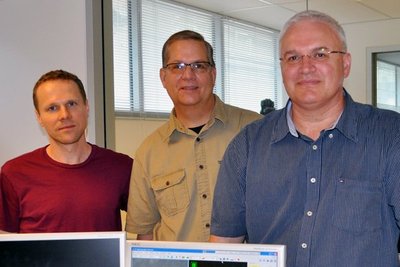UTS facility spearheads research in nanoscale materials physics
Tuesday, 17 April, 2012
A world-first facility giving scientists unprecedented control over the creation and testing of materials at the microscopic level has been commissioned at UTS.
The UTS Faculty of Science has signed a $2 million collaborative research contract with American-based nanotech equipment manufacturer FEI Company that will support a new energy-efficient materials research strength at UTS.
FEI is a world leader in the design, manufacture and distribution of focused electron and ion beam systems for nanoscale research.
As part of the partnership, FEI has donated a novel, research-grade material fabrication and characterisation facility to UTS and is sponsoring Professor Milos Toth as a professorial chair in materials physics to spearhead the research and development collaboration over a five-year period.

The cutting-edge laboratory is the first of its kind applied to research in the field of nanoscale materials physics using electron beams in reactive gaseous environments.
Professor Toth, a former FEI research scientist, said the capabilities of the facility were “revolutionary” and UTS researchers would be the first to benefit.
“This technology allows complex and dynamic material modification processes to be analysed in real time, creating a completely new approach to materials physics,” Professor Toth said.

A highly advanced scanning electron microscope (SEM) enables processes such as the self-assembly of nanostructured materials to be performed in situ and to be studied using ultrahigh-resolution electron imaging and a unique combination of correlative chemical, elemental and optoelectronic analysis techniques.
“This joint research venture is a great opportunity for FEI and UTS to further develop the technology and apply it to help make energy-efficient materials a reality,” said Dr Michael Lysaght, FEI Company’s Director of Research and Technology.
The facility has been installed in a special laboratory built and housed as part of the UTS Microstructural Analysis Unit (MAU).
MAU Director Professor Matthew Phillips said, “The research findings will not only enable real-time dynamic studies of functional materials for sustainable energy applications but will also attract industry, prestigious research grants and facilitate a strong, long-term relationship between UTS and FEI to further develop research in energy efficiency and its applications.”

How librarians can help maintain image integrity
By sharing best practice and providing useful resources, librarians can support researchers in...
Winners announced for 2025 Australian Museum Eureka Prizes
Now in their 35th year, the Australian Museum Eureka Prizes continue to highlight some of the...
"Damning" review of Forensic Science Queensland released
The review of the troubled forensic service provider reveals unreliable results,...





